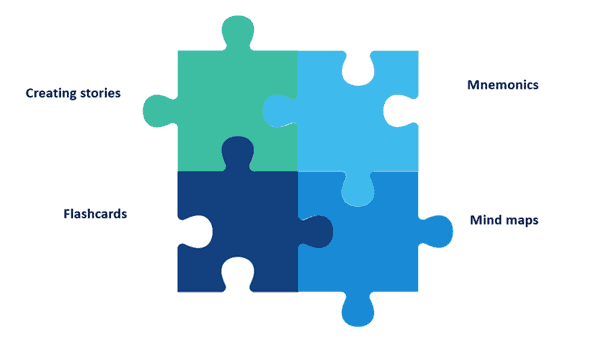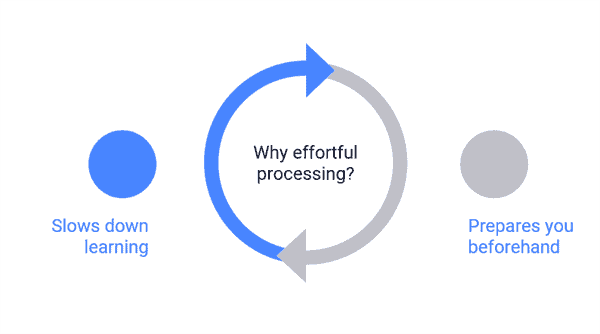Our content is reader supported, which means when you buy from links you click on, we may earn a commission.
Effortful Processing and eLearning

Most of us believe that learning is a process where we remember things, and its subsequent recall shows us how well we’ve learned. However, learning is much more than that.
Effective learning enables us to exhibit our understanding of a subject, build relationships between different ideas, and connect new insights with our existing knowledge base.
Learning is tough, especially when encountering new ideas that we’re not familiar with. In addition, our prior knowledge may sometimes hinder our understanding of new topics. This requires the process of unlearning to learn something new.
Our brain is a complex network of interconnected neurons, the workings of which are somewhat enigmatic to us. However, what is known is that, much like exercising your muscles, our brain also benefits from training. This concept is summarized as effortful processing. Let’s take a closer look at what effortful processing is and how it factors into the process of learning.
What is Effortful Processing?
You must have noticed that sometimes when you come across a new concept, it doesn’t take much effort to learn it. Your mind already makes connections with pre-existing knowledge to help you retain new concepts. You may not even notice it happening, as the new concept may cement itself subconsciously in your mind.
Effortful processing is the complete opposite of this. It stresses the aspect of learning which requires effort, attention, focus, and immersion in order to learn something new.
Let’s take reading as an example. You may have intentionally picked up a book to read. Then you find that your attention span doesn’t enable you to comprehend what you’ve learned. You’ll find that you don’t remember anything the next time you go to read more of the same book. Similarly, memorizing a poem and solving math problems are other examples of effortful processing.
Trying to Remember, Practice, and Rehearse What We’re Trying to Learn is Effortful Processing
Effortful processing is where you physically concentrate on what’s present in front of them. To some, it may come easy, whether through their natural abilities or prior knowledge of the subject matter. What you need to realize is that learning is a lifelong process. It keeps on evolving, given that one exhibits the capacity to learn and discover.
But that’s the thing about learning. It’s not always easy, neither does it have to be for you to see the best results. In fact, training your mind with some strategic challenges can greatly improve the long-term retention of whatever you’re learning.
Baseball and Effortful Processing
Let’s take an example from baseball. Would a pitcher benefit more from a random pitching strategy or a sequenced one?
The problem in pitching randomly is that we love patterns and unknowingly try to exhibit those patterns. That’s because a pitcher is much more suited to throwing balls with a certain accuracy. As a result, they end up following patterns that are not hard to crack for hitters.
For the hitter, it is an easy learning process as they just have to predict what’s coming next. Now that data science has made its way into baseball and hitters have more information about pitcher’s inclinations for targeting an area, the question then becomes, how can randomness be introduced into pitching? This is something that pitchers have to learn in order to remain unpredictable in their game.
One solution to the problem above is finding strategies that introduce a pseudo-random aspect to pitching so the hitter cannot gauge where the ball will be next. In that case, the pitcher bases decisions on a random process.
In terms of learning, what we need to realize is that learners don’t attain mastery of a subject just because they went through a lesson and passed a quiz right after. This is an assessment of short-term recall, not long-term storage.
In order to impact the long-term recall and cement an idea into your mind, you need to put in some work. Rehearsing something every day is a brute force method and will eventually put an idea into your mind, but this process is arduous and inefficient. In order to attain mastery, you need to look for other ways to impact your perception.
Examples of Effortful Processing?
There are quite a number of examples of effortful processing where brute force is simply required to get the job done. However, there are ways to encode information in your brain using simple strategies that mitigate the need for relying on memory alone. The following strategies may help you retain information for longer.

Mnemonics
A mnemonic device is a learning technique that helps when learning new information so that learners retain it longer. Using mnemonics, a learner associates meaning with what they’ve learned via visual cues or word associations. For example, spelling bee competitors often use mnemonic devices to learn and retain spellings for challenging words. Below are some examples of spelling mnemonics:
- Guidance: Greasy Urchins Impaled Darwin Although Napoleon Crushed Enchiladas
- Occurrence: Octogenarians Caressed Chewbacca Unless Rancid Rednecks Embalmed Nutty Cinderella Enthusiastically
- Perseverance: Pettily Edgy Rabid Skinny Enya Violently Exposed Ravishing Altruistic Nude Chimps Eagerly
- Reference: Rats Endured Feminists Except Rings Excluding Naughty Cupcakes Emotionlessly
- Conscientious: Crankily Oblong Neoclassical Stockbrokers Coached Imperial Elegant Noodles To Immortal Official Usher Silently
All the above mnemonics were generated by a random mnemonic generating tool. The first letter of each word in the phrases above spell out the word. However, you can customize it to associate anything with it. Something borne out of your mind that you associate meaning with. This gives it a more of a personal touch and showcases effortful processing when coming up with mnemonic devices to retain information.
The same can be true in reverse. That is, using mnemonic words to memorize a list of things. ROYGBIV commonly stands for the sequence of colors in the visible spectrum of light or a rainbow.
Or, Knights Patronized C-3po Once Frodo Gazed Stylishly can be used to learn taxonomy – how organisms are classified in biology: kingdom, phylum, class, order, family, genus, and finally, species.
Mind Maps
Encoding information is much more challenging than it seems. Sometimes, it requires a conscious effort on our part to imprint a concept, idea, or fact in our minds. However, one thing to remember is that our consciousness enables us to create imaginative scenarios or even retrieve information via visual stimulation. One way of easing effortful processing is by creating mind maps.
Essentially, mind maps let us exploit our senses. To understand it better, let’s explore how our senses factor in when it comes to retaining information better. Our eyes are perhaps the most important sense for learning information; however, retention is what we’re actually after.
Memorization and Mind Maps
Say you made a new friend and visit their place or drop them off at their home. It may take you a few tries to memorize their address. You may even use Google maps initially to make your way there. But, eventually, the route to their place becomes a part of your memory. At some point, you won’t need any assistance. That’s because you’ll navigate based on familiar landmarks or signs to recall the way to their home. Mind maps work in a similar way.
It’s essentially a practice for effortful processing where you cement ideas in your mind by placing them as landmarks. If it’s a sequence of events, you can use multiple landmarks in succession to retain a concept, learn a fact, or remember letters.
What’s important here is that you need to exploit your imagination and visual imaginary to come up with something very personal to your needs.
A subset of mind maps is simply exerting your creativity. It’s like using mnemonics, but with visual representation. You can use an online tool to help you diagram it all out and show the connections between several objects or concepts. You can use lines or even add images instead of text.
The main point is that you’re making a conscious effort to remember things by connecting them with what you’ve seen or imagined.
Flashcards
Another useful technique for effortful processing is by using flashcards. Normally, flashcards are used to memorize words and facts. However, you can customize them for your own needs. It’s a bit of a time-consuming process; however, it produces worthwhile results for retaining information in your memory pool.
The way to use flashcards is in tandem with your imagination described above in mind maps. The problem with imagination it’s sometimes difficult to visualize concepts, and you may need external help or a reference to truly picture it in your mind. The problem with commercially available flashcards is that they are not suited for personal use; instead, they generally describe or state facts on one side.
The way you can use flashcards for retention is by making your own from blank cards. Blank cards of different sizes are readily available in the market and don’t cost an arm and a leg. You can draw a picture on them using your imagination on one side or by using references found elsewhere.
The other side can have information regarding what it entails. Your drawing doesn’t have to be perfect, but adding colors and putting more thought into it will surely yield better results. This way, every time you need to access this memory, the flashcard will come into your mind and its accompanying fact.
Creating Stories
Sometimes you may come across a sequence of events that are linked. You may need to recall them later for use in a test, a procedure, or even your to-do list. Creating a story can help you remember these events without having to rely on sheer memory power.
For example, you need to remember a grocery list: eggs, bread, cheese, milk, onions, and tomatoes. You can link them together in a story like this: the chicken eggs were waiting to hatch while the mother hen fed on bread. Out of nowhere, a cow came running to her for help. The farmer had passed out while milking her to make cheese. They quickly went through the tomato and onion garden to alert his wife for help.
A story like this sounds absurd; however, it will have a lasting effect on your mind for later recall. It doesn’t matter if it’s not ground in reality. The objective here is to link concepts and items together in the story to make their relationship apparent.
Why is Effortful Processing Important?
When learning something very monotonous, our mind tends to resist it as there’s just no incentive to learn it. What we need to do is trick our brains into releasing dopamine while we’re learning. That way it becomes a process we look forward to every time we read a book or study something. In situations like these, effortful processing is your friend.

Using the techniques described above, let’s take a look at how effortful processing helps us:
Slows Down Learning
Sometimes when we’re learning new things, our mind doesn’t have enough time to comprehend and relate them with other things. This lag in learning becomes apparent with age. Just think of the time you were in middle school. Whatever you learned seemed extremely daunting at the time. But, as you progressed, it seemed to become easier. At the university level, it becomes even simpler. Interacting with the subject matter can help you come to conclusions and follow-up questions. It excites your curiosity and lets you exhibit your creativity.
Prepares you Beforehand
Although rote memorization classifies as a method for effortful processing, since it serves to encode information, albeit by force, into our minds, it fails to deliver when it comes to retention. Moreover, you’ll be frustrated when you realize that you fail a real-life application of something you learned but passed all its testing metrics.
By effortful processing strategies, you instill knowledge of what you’ve learned. It enriches the quality of learning and helps you prepare for real-world situations.
What Type of Memory is Related to Effortful Processing?
A common question regarding effortful processing is related to the part of the brain that stores information. Is effortful processing related to short-term memory? There’s no definitive answer to this as we’re still trying to figure out how memory works and how synaptic connections are made so they leave a permanent mark inside our brains. All we know is that the capacity of the brain to learn and remember is within our bounds. We just haven’t figured out the switch that can enable us to retain information for as long as we’d like.
We know that we learn some things naturally – for example, trauma. Whether mental or physical, it cements itself in our brains, preventing us from repeating a sequence of events that leads to the same trauma. No matter how much time has passed, the trauma imprints in our minds and deters us from ending those situations in the first place.
Repetitive Actions and Memory
We also know that repetitive actions tend to take place in our minds without us having to think much about them. Essentially, we’re talking about muscle memory here.
For example, once you start learning how to drive, it takes some time to get used to it. Learn how gears work, the important traffic laws to follow, how to remain vigilant on the road, etc. But, as we gain experience, our mind keeps these processes in the background. This way, driving comes to us naturally.
But, if you haven’t driven for a while, it may take some time for you to get used to driving again. This may lead to the conclusion that there’s sort of a buffer in our minds for collecting short-term memories and a larger repository for synaptic stimulus in the long run. That is to say, our minds are configured so they keep the short-term buffer for memories that will help us in our daily lives, a library we can access quickly.
This buffer may change over time depending on how often we access it. Our brain probably prioritizes those that we access more often than others. Perhaps this is a good explanation as to why we don’t remember the bulk of what we’ve learned.
Conclusion
Associating learning with events and visuals from our short-term memory can explain the working mechanism of effortful processing. However, there is no definitive way of knowing as we still haven’t completely figured out how the mind works.